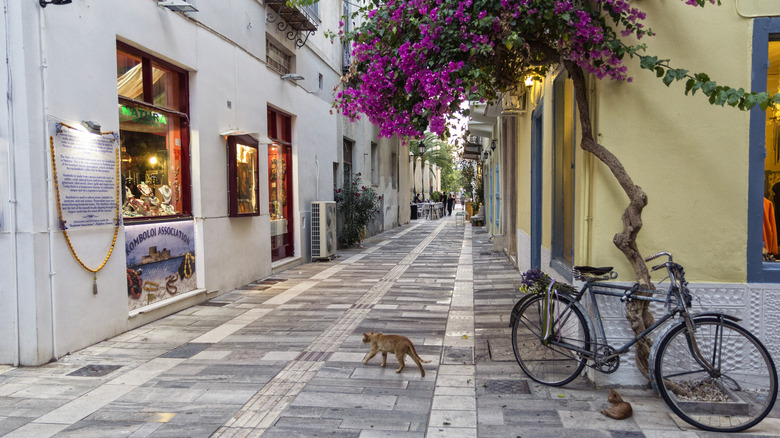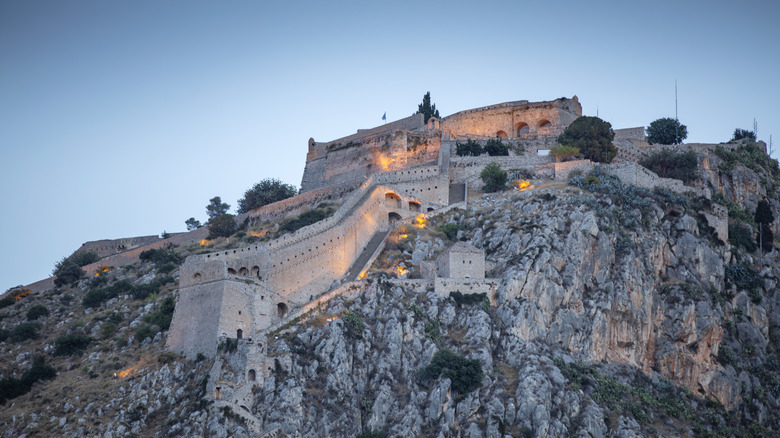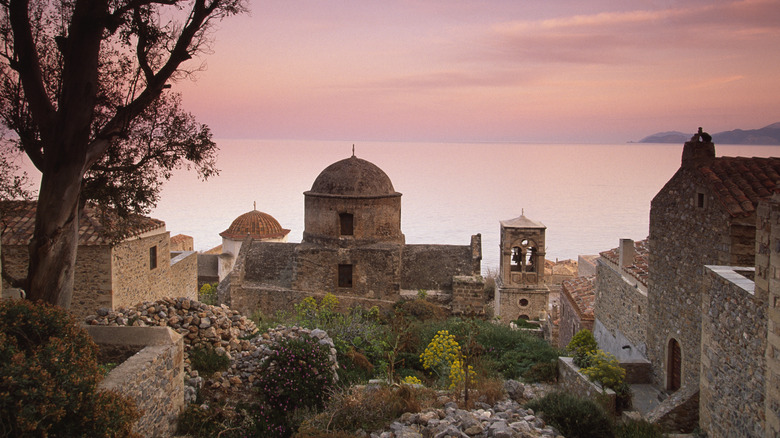Rick Steves Says This Is The Best Hotel To Stay At In Nafplio, His Favorite Small Greek Town
Intrepid traveler Rick Steves has made no secret that Nafplio is his favorite small Greek town. On the Peloponnese peninsula, Nafplio has all of the classic charms of small towns in Greece, like stone buildings with vibrant pink bougainvillea climbing the walls, a harbor lined with lively restaurants, and plenty of places to take a dip in the azure Aegean Sea. It isn't difficult to see why Steves is such a fan.
If you want to visit Nafplio, you don't need to waste time searching for accommodations — Steves has you covered. The experienced travel expert raves about Pension Marianna on his blog, highlighting the "amazing breakfast," which guests can enjoy with rooftop views. In a video posted on his YouTube channel, Steves shows a mouth-watering organic spread of local olives, marmalade, yogurt, cakes, and cheese pie. Stepping onto the roof terrace, Steves pans to panoramic views of Nafplio, with the city's Venetian fortress above him, while across the bay, you can see Argos, a historic city considered one of the oldest in Europe. It's no surprise that Steves fell in love with this family-run hotel.
While Steves' video from the hotel was posted nine years ago, more recent visitors have also fallen for Pension Marianna's charms. Tripadvisor reviews from within the month before this article was written are outstanding. Pieter G praises the friendliness of the owners and calls the location "spectacular," while Karen L writes that the "breakfast was fantastic, not only the view but the food as well."
Exploring Rick Steves' favorite Greek town
Nafplio is just a two-hour drive from Athens, but the town is refreshingly uncrowded. In fact, Steves calls the Peloponnese an underrated paradise, with a wealth of history, glorious landscapes, and incredible food. Why make a beeline for Nafplio and not one of the other towns on the peninsula? According to Steves, Nafpilo is easily "the most charming town in the Peloponnese."
Much of the pleasure in Nafplio is in wandering. The sun glistens off the whitewashed buildings, and Venetian houses line the shady alleyways, revealing elegant courtyards with Ottoman-era fountains. You can climb the 999 steps (857, actually, but don't spoil the story) up to the 19th-century Palamidi Fortress to explore the remains of the walls and bastions and enjoy stunning views out to sea. Alternatively, take a gentle stroll along the beach promenade, where you can access the gently lapping water.
After a hearty breakfast at Pension Marianna, it'll probably be dinnertime before you are hungry again. If so, it's time to experience what Rick Steves calls Nafpilo's "thriving evening scene." Try regional specialties like lamb, goat, and roast pork, or enjoy local artichokes, feta, and fruits. Find a restaurant by the water and enjoy the evening breeze, or simply sit in Syntagma Square and watch the world go by.
Exploring the Peloponnese
Nafplio and Pension Marianna are an excellent base for further exploration of the Peloponnese. Ancient Mycenae lies a short drive north of town. A great city in the 15th to 12th centuries B.C., having featured in Homer's "Iliad" and "Odyssey," Mycenae is now a place of atmospheric ruins. Another ancient site an hour to the east of Nafplio is Epídavros (or Epidaurus), most famous for what Rick Steves calls "the best-preserved theatre in the ancient world" in his video, "Greece's Peloponnese." Climb the many tiers to take in the view from the top and, of course, test the acoustics as fascinated visitors stand in the center far below and find their voices carried all the way up.
If you want to discover more of this corner of Greece, check out Monemvasia, an underrated destination for a romantic getaway. Monemvasia is a town hewn out of an imposing rock, a fortress you can only access across a narrow causeway. The lower town is a captivating jumble of medieval buildings dating from the 13th to 17th centuries, with pleasant cafes and restaurants overlooking the Aegean Sea. The upper town is in ruins, with the only surviving building a 14th-century Byzantine church.


